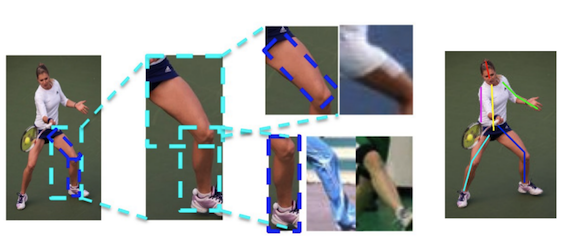Beyond Physical Connections: Tree Models in Human Pose Estimation
Fang Wang and Yi Li
{fang.wang, yi.li}@nicta.com.au
 |

|
Simple tree models for articulated objects prevails in the
last decade. However, it is also believed that these simple
tree models are not capable of capturing large variations in
many scenarios, such as human pose estimation. This paper
attempts to address three questions: 1) are simple tree models
sufficient? more specifically, 2) how to use tree models
effectively in human pose estimation? and 3) how shall we
use combined parts together with single parts efficiently?
Assuming we have a set of single parts and combined
parts, and the goal is to estimate a joint distribution of
their locations. We surprisingly find that no latent variables
are introduced in the Leeds Sport Dataset (LSP) during
learning latent trees for deformable model, which aims
at approximating the joint distributions of body part locations
using minimal tree structure. This suggests one can
straightforwardly use a mixed representation of single and
combined parts to approximate their joint distribution in a
simple tree model. As such, one only needs to build Visual
Categories of the combined parts, and then perform inference
on the learned latent tree. Our method outperformed
the state of the art on the LSP, both in the scenarios when
the training images are from the same dataset and from the
PARSE dataset. Experiments on animal images from the
VOC challenge further support our findings.
Presentations
Experiment results
Click here to see more experiment results.
download code here (22.5MB) ( README )
download relabeled LSP data here
download code here (22.5MB) ( README )
download relabeled LSP data here
Reference
@article{fwang2013pose,title={Beyond Physical Connections: Tree Models in Human Pose Estimation},
author={Fang Wang and Yi Li},
booktitle = {CVPR},
year={2013},
}